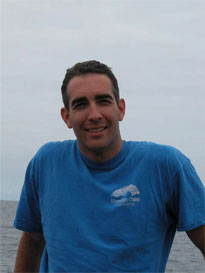OOI Mapping Cruise 2008
Voices of the Fishes
Light, water, polymers, electricity, and dreams, these are the elements of a project lovingly called “the school of fish.”
As a land-lubbing experimental physicist in the Biodesign Institute at Arizona State University, I’m used to building apparatus with the comparatively unlimited power and resources available in my laboratory. I use high-energy, ultrafast lasers to manufacture photonic structures and sensors with nanoscopic resolution. I make these structures so small that they mold the flow of light by interference, changing their color or brightness in response to the presence of even a single molecule. It’s a different world from the massive metallic beasts like Sentry and TowCam.
This adventure is actually my first oceanographic cruise. In the past week I have gained a great respect for deep-sea engineering. Robots that can live beneath 400 atmospheres of crushing water are no small feat! Sentry’s autonomous dance at the bottom of the sea is most impressive. TowCam’s pictures, once brought up, reveal never-before-seen beauty in high-definition. The data these robots provide are clearly unparalleled and imminently useful. But really, no offense to my shipboard science colleagues…. it’s all just so… well… late twentieth century.
In contrast, the dream of “the school of fish” borders on science fiction: An ad hoc network of tiny, semi-autonomous robots, swarming about
hydrothermal vents and gas-hydrate pinnacles, reporting back to a
central hub 24 hours a day, seven days a week all wirelessly connected
to and powered by a local undersea node. Cutting-edge materials like electro-kinetic polymers allow these “fish” to swim about. Mostly water, their design will embrace the pressure rather than fight it. Of course the term “fish” is used loosely; these bots may actually look more like neutrally buoyant plastic bags or flashing spheres about the size of a softball. Their solid-state, optical sensors and controls will make minimum use of energy and space. Their telemetry and data transmission will operate at frequencies that used to be only possible on land. So advanced, if one of these little swimmers were captured and examined by scientists from even a decade ago, their function would be mysterious and opaque, no doubt the work of an advanced alien civilization!
My recent thoughts on the robo-fish were inspired by the vision and prior efforts of Dr. John Delaney at UW and Dr. Deirdre Meldrum, who is now at the Biodesign Institute at Arizona State University. Our project is fundamentally enabled by the permanent seafloor power source that the OOI Regional Scale Nodes will provide. These tiny, soft-skinned robots will be made so inexpensively and in such large numbers that their loss to the hungry denizens of the sea is just part of the plan (not a joke, they might get eaten by squid or large fish attracted to their flashing light!). Their ubiquitous presence and relentless data collection will be streamed back to the node and on into our labs, classrooms, and home entertainment systems.
I have genuinely loved every minute of this voyage and am eager to learn more in the coming week, but as I stand on the deck in the moonlight, looking out over the dark waves, my stomach only slightly lagging behind the undulation of our hulking ship, I can’t help but feel pulled in two directions. Part of me is at home in the desert (I just got married three weeks ago) and the other part of me is here, at sea. No longer a land lubber, I know I will never again be the same. The ocean’s pull will color my research. I’m thinking about a robo-fish prototype to bring back within the next year. Maybe then my wife will be able to join me and complete this whole equation.
Related Content
Voices
- Newbies, Oldies and 21st Century Oceanography
- Going to Sea
- Once and Future Oceanographer
- The Oceans: Medicine Chest for the World
- When Your Home Bobs
- Seas of Opportunity
- Voices of the Fishes
- Oceanography as an Opportunity to Contribute
- The Water Column
- Ocean Heritage Guides this Oceanography Major
- Theater in the Round


